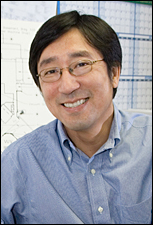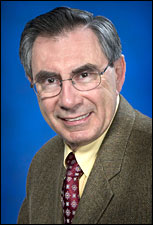Two Brookhaven Lab Scientists Named AAAS Fellows
January 6, 2010
UPTON, NY — The American Association for the Advancement of Science (AAAS) has awarded two scientists from the U.S. Department of Energy’s Brookhaven National Laboratory with the distinction of Fellow. Chi-Chang Kao and Thomas Ludlam will be among 531 AAAS members to receive this honor for their efforts toward advancing science applications that are deemed scientifically or socially distinguished. The new Fellows will be presented with their official certificate and rosette pin on February 20, at the 2010 AAAS annual meeting in San Diego.
Chi-Chang Kao is recognized for “his many contributions to resonant elastic and inelastic x-ray scattering techniques and to x-ray spectroscopy, their applications to important materials, and his inspired leadership at the National Synchrotron Light Source [NSLS].”
Kao’s research interests have focused on developing new experimental techniques using synchrotron light at Brookhaven Lab’s NSLS, a facility where, each year, approximately 2,100 scientists from around the world use x-rays, infrared light and ultraviolet light to study materials as diverse as computer chips and viruses. Specifically, Kao has developed x-ray techniques to study superconductors, materials that have no electrical resistance at very low temperatures; magnetic materials for storage devices in computers; and electronic structures of materials under high temperature and high pressure.
As chair of the NSLS, Kao manages a staff of about 170, and he has organized a large community of scientists to address scientific opportunities that he has identified. He also undertook major upgrades to the scientific programs and experimental facilities at the NSLS. In addition, he developed potential science programs for NSLS-II, Brookhaven’s new light source that is currently under construction.
“I am honored to receive this distinction from the AAAS,” Kao said. “It is a privilege to work with the talented and dedicated staff of the NSLS, and I am looking forward to continuing our productive scientific programs at NSLS-II.”
In 1988, Kao earned a Ph.D. in chemical engineering from Cornell University and joined Brookhaven Lab as a postdoctoral research associate. He worked his way up the ranks to become a senior physicist in 2001, and, in that same year, he was named associate chair for user science at the NSLS. In 2005, he was promoted to deputy chair of the NSLS, and in 2006, he became interim chair and then chair. In 2008, he became director of the Joint Photon Sciences Institute at Brookhaven Lab, an interdisciplinary research institute that uses advanced light sources to address challenging problems in science and technology. Kao has been an adjunct professor in the Physics Department at Stony Brook University since 2003.
Thomas Ludlam is cited for “the establishment of the scientific program of the Relativistic Heavy Ion Collider [RHIC] at BNL and for his leadership [in] preparing the detectors for RHIC.”
Ludlam played a major role in the development of Brookhaven’s world-class accelerator, RHIC, from its design stage starting in the early 1980s to the design and construction of its four detectors and the development of its research programs. RHIC began operations in 2000, colliding high-energy beams of heavy atomic nuclei, known as heavy ions, for experimental studies performed by physicists from around the world.
The heavy-ion collisions at RHIC allow the study of nature’s strongest force, through the interactions of subatomic particles called quarks and gluons, by creating an extraordinarily hot and dense type of matter that is thought to have characterized the universe a few millionths of a second after the Big Bang. In 2005, physicists at RHIC found such a state of matter, and discovered that it behaves like a “perfect” liquid.
“The RHIC program has been – and continues to be – a wonderful adventure,” Ludlam said. “I am grateful to have been a part of it from the beginning and honored to be recognized in this way by the AAAS.”
Ludlam earned a Ph.D. in physics from Yale University in 1969 and began his career on the faculty of Yale. He joined Brookhaven in 1978 as an associate physicist and rose through the ranks to become a senior physicist in 1994. From 1990 to 1999, he served as associate project head for RHIC construction. In 2004, he became associate chair of nuclear physics within Brookhaven’s Physics Department, and, in 2007, he was named chair of the Physics Department. Ludlam is a Fellow of the American Physical Society.
2010-11060 | INT/EXT | Newsroom











